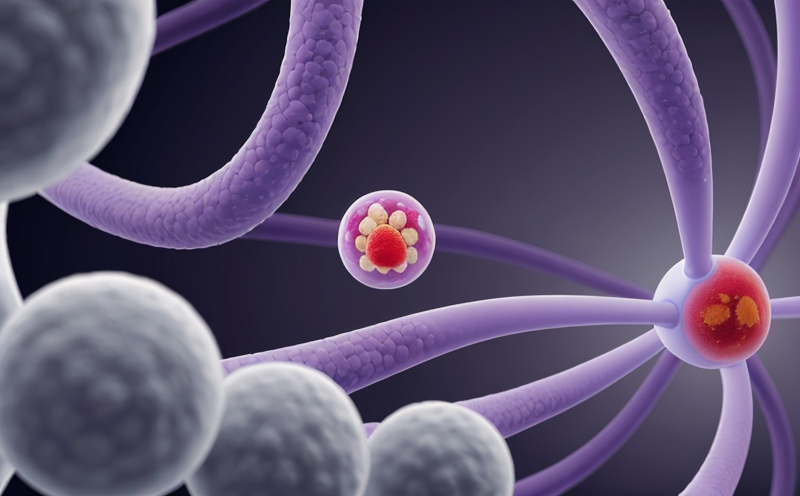Tumor Angiogenesis Marker CD105 Testing in Animal Models
The tumor angiogenesis marker CD105 testing is a crucial procedure within the realm of clinical and healthcare testing, particularly for cancer biomarker analysis. This test focuses on identifying and quantifying CD105 (endoglin), a transmembrane protein that plays a significant role in the formation of new blood vessels (angiogenesis). In animal models, this testing helps researchers understand how tumors grow and spread by examining the extent to which they promote angiogenesis.
CD105 is expressed on endothelial cells during angiogenesis. Its presence can indicate increased vascularization within a tumor, which correlates with enhanced tumor growth and metastasis potential. By measuring CD105 levels in animal models, scientists can assess the efficacy of anti-angiogenic therapies, evaluate new drug candidates for their ability to inhibit tumor-induced angiogenesis, and determine the biological behavior of tumors.
The process involves several key steps: first, selecting appropriate animal models that mimic human cancer conditions. Commonly used models include nude mice xenografts or genetically engineered mouse models (GEMMs). Next, tissues are collected from these animals post-experimentation, after which they undergo detailed histological analysis and immunohistochemical staining for CD105 detection.
Microscopy techniques such as confocal laser scanning microscopy provide high-resolution images of the stained tissues. These images allow researchers to visualize CD105 expression patterns precisely. Additionally, quantitative analyses using image processing software help in measuring the density of CD105-positive blood vessels within tumors.
Understanding tumor angiogenesis through CD105 testing is essential for developing personalized cancer treatments that target specific pathways involved in tumor growth and metastasis. This approach not only enhances therapeutic outcomes but also reduces side effects by focusing on mechanisms uniquely associated with cancer progression.
The importance of this test extends beyond just academic research; it has direct implications for patient care. By identifying which patients might benefit most from treatments that target CD105, doctors can tailor their approaches more effectively. Furthermore, insights gained from studying CD105 in animal models contribute to the development of novel diagnostic tools and predictive markers for cancer progression.
Why It Matters
The significance of tumor angiogenesis marker CD105 testing lies in its ability to provide critical information about how tumors grow and spread. Tumor growth depends heavily on the formation of new blood vessels, a process known as angiogenesis. By monitoring CD105 levels, researchers can track changes in vascularization over time, which directly impacts tumor biology.
- Enhanced Drug Discovery: Understanding how tumors respond to anti-angiogenic drugs is vital for drug development. This test helps identify effective compounds aimed at inhibiting tumor angiogenesis.
- Predictive Markers: CD105 levels can serve as predictive markers of treatment response, allowing clinicians to make informed decisions about patient care.
- Better Treatment Strategies: Insights from this testing contribute to the design of more precise and effective cancer therapies tailored specifically for individual patients.
In essence, CD105 testing in animal models is a powerful tool that bridges basic science with clinical application, offering valuable data needed both by researchers seeking new knowledge about cancer biology and clinicians striving for better patient outcomes.
Benefits
- Precision Medicine: Provides precise measurements of CD105 levels, enabling targeted therapies based on individual tumor characteristics.
- Efficacy Assessment: Allows evaluation of the effectiveness of anti-angiogenic drugs in reducing tumor growth and metastasis.
- Translational Research: Facilitates the translation of laboratory findings into clinical practices, improving overall cancer treatment strategies.
- Improved Outcomes: Helps predict which treatments will be most beneficial for specific patient populations, leading to enhanced therapeutic outcomes.
The comprehensive nature of this testing ensures that all aspects influencing tumor angiogenesis are accounted for, providing robust data essential for advancing cancer research and treatment.
Why Choose This Test
- Accurate Measurements: Utilizes advanced histological techniques to ensure precise quantification of CD105 expression in tumor tissues.
- Variety of Models: Offers a range of animal models that accurately represent human cancer conditions, enhancing the relevance of findings.
- Comprehensive Analysis: Includes both qualitative and quantitative evaluations to provide a holistic view of CD105 involvement in tumor angiogenesis.
- Regulatory Compliance: Adheres strictly to international standards like ISO 15195-3, ensuring reliability and consistency in testing protocols.
Selecting this test ensures that you receive the highest quality data necessary for robust research and development initiatives. The combination of precision, versatility, comprehensiveness, and compliance guarantees accurate interpretations and actionable insights into cancer biology.





